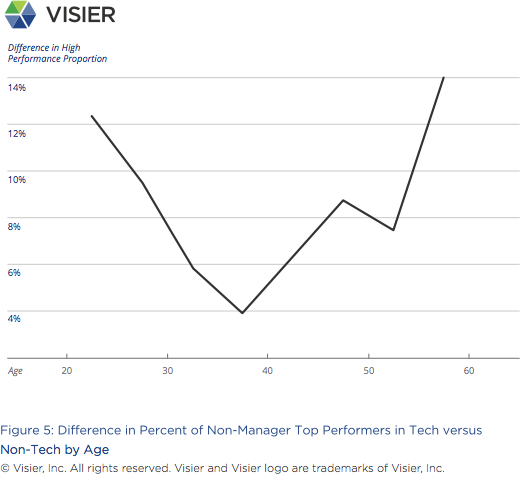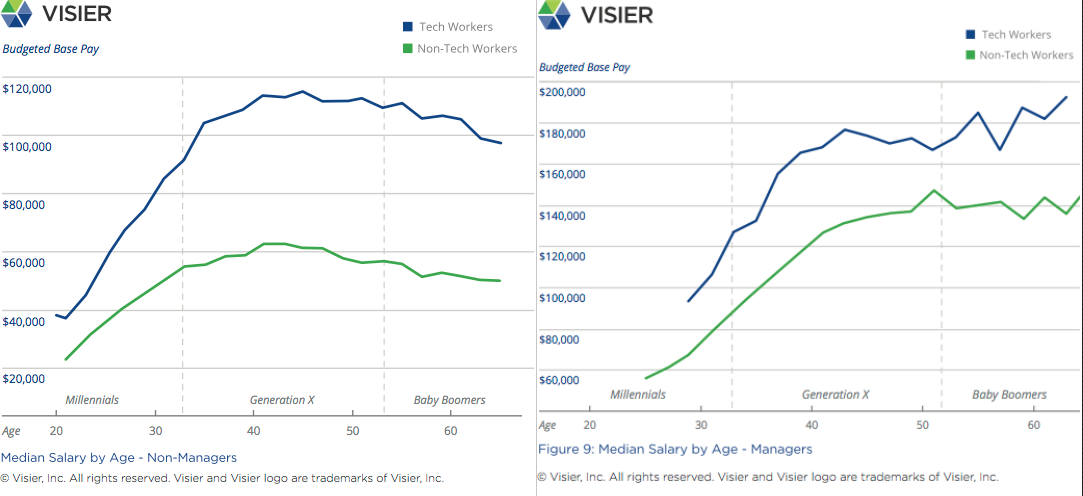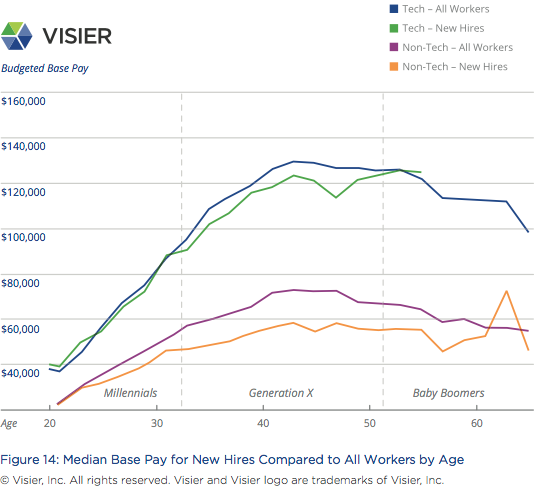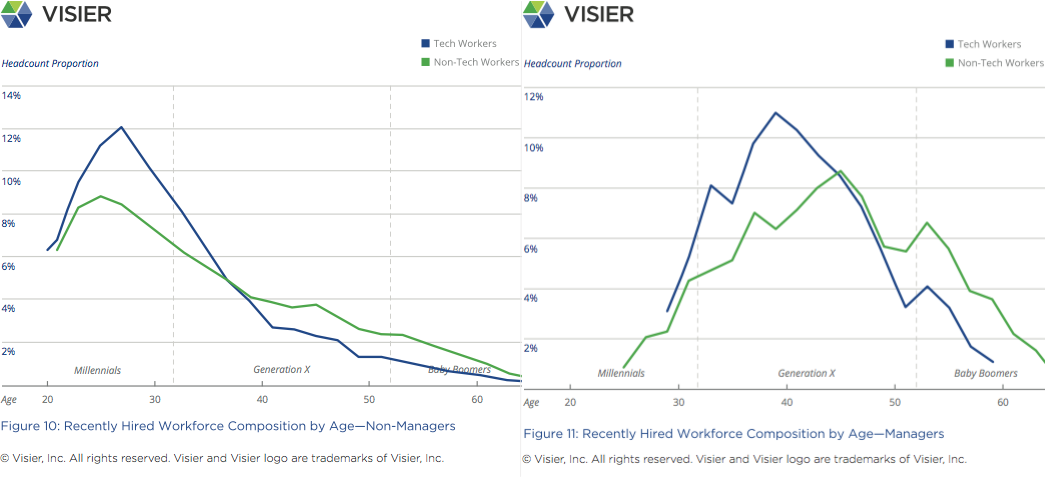Four Common Tech Ageism Myths Debunked With Data
Experience and maturity are more valued in tech. We call this the “Tech Sage Age.” Here are four tech ageism myths debunked with the data.

It’s been called the tech industry’s “silent career killer.” Between 2008 and 2015, it was the subject of 226 official complaints filed against Silicon Valley’s biggest tech companies. And some experienced workers are even having plastic surgery to hide it.
Age, and how it impacts the way a worker is treated, is not a veiled issue within the tech industry. In recent years, a flurry of stories have surfaced about experienced tech workers being laid off and replaced by younger employees, or older employees remaining unemployed for painfully long periods.
Situational ageism — prejudice or discrimination on the basis of a person’s age — undoubtedly exists in the tech industry. But is it happening on a widespread, systemic level?
This question — one we sought to address with our latest Visier Insights report — has traditionally been difficult to answer: While leading tech companies openly publicize their organizational diversity data in terms of ethnic and gender composition, little data has been shared about the age makeup of the tech workforce.
We began our research into ageism by looking at the breakdown of the workforce by age, comparing the tech industry to non-tech industries. Using the Visier Insights database — an aggregation of anonymized and standardized workforce databases that for this report included 330,000 employees from 43 large US enterprises (a subset of Visier’s customers) — we were able to examine the role of age in the workforce like never before.
Ageism in Tech: What 330,000 Anonymous Employee Records Revealed
What did we find? In short, the average tech worker is 38 years old, compared to 43 years old for non-tech workers. The average manager in the tech industry is 42 years old, compared to 47 for non-tech industries.
It comes as no surprise that tech workers are younger on average, but we were also able to clarify some key misconceptions related to the salary lifecycle, resignation rates, and perceived value of older workers. In reality, experience and maturity are more valued in tech than in non-tech industries. We call this the “Tech Sage Age.”
Here are four common tech ageism myths we debunked with the data:
Myth #1: Older tech workers are less valued
While the average tech worker is five years younger than the average non-tech worker, it is a misconception that older workers are less valued in tech. From age 40 onwards, non-manager workers in tech enter the Tech Sage Age and are increasingly likely to receive a top performer rating as they age, mature, and gain experience. Conversely, the proportion of top performers decreases with age in non-tech industries.

Myth #2: Older tech workers experience a drop in salary
Older tech workers as a group do not experience a reduction in average salary that is any different from non-tech industries. Rather, workers in tech experience the same salary lifecycle as their counterparts in non-tech.

Myth #3: Newly hired older tech workers are not paid equitably
Older tech workers that are newly hired do not — on average — experience a lower wage. Rather, newly hired workers are paid the same average salary as more tenured workers, across all age groups.

Myth #4: Older workers in tech resign at higher rates
The average resignation rates by age for tech and non-tech workforces show that older tech workers — from age 40 onwards — have the same first-year resignation rate as their non-tech age counterparts: approximately 10%.

Reality: Systemic Ageism Exists in Tech Hiring Practices
Despite our Tech Sage Age finding (where older workers in tech are increasingly rated as Top Performers as they age compared to Non-Tech workers), there is systemic ageism in tech hiring practices: Tech hires a higher proportion of younger workers and a smaller proportion of older workers than non-tech.

Is this disparity in hiring due to ageism in tech? To investigate this, we first strove to determine if the disparity is related to the availability of talent versus to an intentional bias towards hiring younger workers. We found that hiring decisions in tech do indeed favor younger candidates, hiring Millennials over Gen X candidates at a higher rate than in non-tech industries.
The Value of Including Older Tech Workers
As our Tech Sage Age finding shows, companies may be missing out if they don’t consider the age composition of specific teams, departments, and business units and how managers can build diversity.
Legal issues aside, designing a recruitment strategy around younger generations can be shortsighted from a business perspective. Older workers tend to be more loyal, and an over-representation of millennials in the workforce can impact retention. A 2016 Gallup report reveals that “21% of millennials say they’ve changed jobs within the past year, which is more than three times the number of non-millennials who report the same.”
A workforce of job-hoppers can have a big impact on the bottom line. As HR expert Josh Bersin writes in this post, “the total cost of losing an employee can range from tens of thousands of dollars to 1.5 – 2 X annual salary.”
Studies have also found that diverse teams are more innovative, which is critical in an era when competitive threats loom large. Hiring people “who do not look, talk, or think like you can allow you to dodge the costly pitfalls of conformity, which discourages innovative thinking,” write the experts in this HBR post.
At Visier, we always look for opportunities to leverage the wisdom of well-connected, experienced workers. Lexy Martin — who has more than 40 years of thought leadership experience in introducing workplace initiatives and emerging technologies — joined our company in June of 2016. She works closely with Visier customers to support them in their HR transformation.
A septuagenarian herself, Lexy has many baby boomer friends who continue to work. According to her, “we [baby boomers] are living longer, we’re healthier, and we’re fully engaged.”
Her advice to her age peers, while “it’s sometimes awkward working with younger workers… listen with empathy and contribute in whatever way you know possible.” Maybe “serving and learning, interning and mentoring, being a student and a sage” is the what the Tech Sage Age is about.
What Businesses Can Do
There are a number of important steps employers can take to ensure they root out the risk of ageism in their workforce, and acquire the best and brightest talent available, regardless of age:
Review your workforce data to understand the current state of age equity within your organizations to find any signs of potential bias in hiring, promotions, salary levels, turnover, and performance ratings.
Set objectives and develop a plan with manageable steps (and a way to monitor your progress) that will help your organization achieve an inclusive work environment.
Keep in mind that, as with ethnic and gender equity, age equity is a cultural issue — if pockets of ageism exist within your organization, you will need to devise plans to address them not only via better HR practice and policy rollouts, but through culture change.
Consider implementing a version of the Rooney Rule for age, specifically for teams or roles where the workforce is less diverse in age: for every position you have open to fill, consider one or more older candidates (or candidates that will help create a more diverse team, in general).
Develop hiring practices that reduce the potential for intentional or unintentional bias in the screening out of older applicants.
Develop hiring practices that specifically do not screen out candidates based on the length of their unemployment — while this report focused on systemic ageism, many individual stories suggest older unemployed workers struggle to get hired, and studies indicate recruiters screen out candidates that have been unemployed for longer periods of time.



